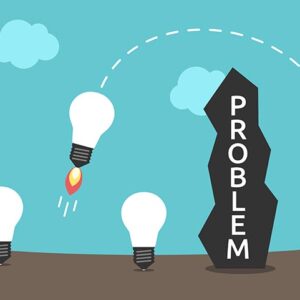Problems and the SOuLVAS Drive

Problems, problems, problems. Any moment a story is told about life, a major chapter in that story is about problems. Some commentators have even declared that life without problem would not be worth living. The understanding of this pervasive occurrence in life is derived from an analysis of what is meant by problems, when and why they occur. As part of the SOuLVAS journey this is point of departure from which we set off. The ways in which we go about solving this problem which are the methods and working tools are the bedrock of SOuLVAS armoury through which problems are tackled, the people’s motivation and drive is a big component of this journey as well the mind-set.
1.0 Problems Definition
Problems are defined as
Problem is derived from the Greek word Problema which means obstacle. It can be further derived that a problem is an issue or situation that stand in the way of someone when they want to achieve and certain aim or objective.
Definition
‘’matter or situation regarded as unwelcome or harmful and needing to be dealt with and overcome’’
Oxford Dictionary
1.1 Types of Problems
At the top end problems can categorised at into two set. These are structured problems and unstructured problems. Everyone remembers very well either with joy or anguish mathematical problems which for part of every curriculum. These are an example of structured problems. A set of formulas and a knowledge of mathematical concepts is needed to solve these problems. A doctor carrying out a diagnosis on a patient uses a set of laid out protocols that help arrive at a conclusion the cause for the illness and further how best to treat the disease. Any civil leader deciding on the course of action in handling some unrest is faced with an unstructured problem. The problem is multifaceted and cannot be classed as falling into a specific field only.
1.2 Sub-Categories of Problems
The problems that SOuLVAS deal with come under many categories. Using Jonassen (2000) categorisation of problems, most of the problems that are dealt with by the SOuLVAS community are shown below. These are arranged starting with the most well-structured problem to the least structure problem.
- Algorithm- these are problems which are solved through the deployment of a step by steps instructions. These are often repetitive tasks which need the same outcome to be attained every time.
- Story Problems- These are feature in technical texts and literature. The story presented feature a limited number of elements. They approach is scholarly and is often criticised as too narrow to be applied in practical situations that cover many subjects. Imagine the problems featured on a Thermodynamic text book, the story problems featured would need the use of formulas to
- Rule using/ rule induction problems- In this case there are many routes to the solution. The problem solver determines the best route that they will take to the solution. An example of such a problem is the need to arrive at a certain destination as a defined time. How the person gets there is entirely upon them as long as the arrive a destination (solve problem).
- Decision Making- One of the role of leaders and managers of entities is to make decision. These are meant to chart the best path for the organisation. The leadership first recognised the need to make a decision either from a deviation from the plan or a problem that arises. The leader would the gather further information about the situation, identify alternatives and choose the best solution/decision based on the evidence supporting it.
- Trouble shooting – Associated with getting machinery to function as required. Strategies applied her include elimination, search and replace, space splitting and fault establishment.
- Diagnostic- In this case the problem solver seeks to establish the reason for the fault. This is associated with health personnel eg a Doctor. Possible solutions are suggested
- Strategic Performance- These are obstacles experienced in the process of achieving tactical objectives. A series of carefully planned manoeuvres that address strategy issues of an entity, team of individual.
- Policy Problems – These are related to the general guide as to how things are carried out. Policy problems as an example could be how to increase economic activity among the population. Legislators, policy makers and policy analyst have to consider these issues and produce a policy that addresses them. The involvement of SOuLVAS is to guide policy makers and facilitate through involvement of the SOuLVAS Community.
- Design related -The problems that need design related intervention are ones where there is needs to be put in place a system, products or way of dong things that corrects the identified problems. An example of this is the need to address issues of cattle going astray in communal farming areas. A product or system will have to be designed to solve the issue.
- Dilemmas- Imagine this problem. The increase in elephant population in the country Botswana. A lot has been said about protecting to ensure they face extinction. However for the local human population these increased number of elephants are a nuisance as the destroy their infrastructure and fields. For the political leadership this is an example or a problem which presents itself as a dilemma
2.0 Problem Solving Steps
The great emphasis of the SOuLVAS way is the availing of tools through with problem solvers can solve the problems in the different categories shown above. The initial steps involve the definition of the problem at hand. Through the use of the eLxA a framework is outlined that helps people go through the stages of Planning, Operationalising, and getting support of the SOuLVAS Central and well as monitoring their progress.
2.1 SOuLVAS ROLES
Mat’ada Shatter
These are the general everyday people who go about living their lives. As the do they pick and identify problems in hinder them from attaining the life objectives. The eLxA allows people to set objectives and to continuous monitor how they fare as the go through life. This will be the first indicator of problem. Once the problems have been identified and the SOuLVAS project charter completed, they are presented to SOuLVAS Central to allow them guided process to be undertaken. It is very common that the same problem affects and impacts many people who are part of the SOuLVAS Community. Once published common approach and engagement will be achieved. SOuLVAS Central will take Mat’ada Presenter through the defining and structuring of the problems
Mat’ada Shatter
The Mat’ada Shatter are keen problem solvers. Armed with knowledge, training and skills in defined areas, the SOuLVAS Central polishes their problems solving skills to allow them to partake in the problem solving process. The various professions out there from industrial related ( eg mining, manufacturing), services to arts and policy makers can a difference in their fields and any other related fields. It is also worth noting that creative and lateral thinking is achieve through looking at a problems in a define area through a fresh set of eyes. Mat’ada Shatters are required to reach SOuLVAS Central for the registering and on boarding. The Mat’ada Shatter will partake in the analysis of problems, with the generation of solutions and finally the best solution to be implemented
Communicator & Solimplimentor
Once the solutions for problems have been identified they are implemented in the best way possible. The general acceptance of the solution is needed. The right communication is carried out to enable it to reach the targeted people. The coordination of this implementation is carried out by SOuLVAS Central. The Mat’ada Presenter and Mat’ada Shatter are the problem owners and hence take centre stage in the implementation of these solution. SOuLVAS Central keeps track of these implementation
Evaluator and Improver
The problem solving process is a back and forth process, with preceding steps being revisited to allow, when needed, further refining of the solutions. This is made possible by the continuous evaluation of the outcomes from the solutions and the benefits accrued. The improved solution offers insights which can be continuously used to generate new ways of solving the problem
3.0 Word of Caution for Problem Solvers
There are a number of Pitfalls that Problem Solvers need to avoid. These are include
- Inadequate defining of the problem. The problem has to be defined in such a way that it enables solving to be done accordingly. Biases and personal issues have to be avoided
- Concluding on a solution before a hypothesis is made and tested.
- Insufficient analysis of the problem, this misses out on the opportunity to understand the problem deeper. On the other end paralysis by over analysis also has to be avoided
- Lack of an implementation plan
- Believing that there is only one way to solve a problem
4.0 Activities in the SOuLVAS
4.1 Mat’ada Presenter
| Activity | Frequency |
| Problem Siren– Highlighting and submission of problems to SOuLVAS Central so they could be subjected to the process | Daily |
| Guided Implementation-Use of eLxA Guided Implementation and Auctioning Canvas to pick anomalies in everyday lives that are problems | Daily |
| Solution Selection: Contribution to the Solutions Selection from a number of selected solutions | Weekly |
| Solution Implementation: Own the solutions and Implement to improve their lives | Daily |
| Feed Back Loop: Suggest new improvements and ways of carrying out activities | Monthly, Yearly |
4.2 Mat’ada Shatter
| Activity | Frequency |
| Problem Decomposition – Breakdown the assigned problem into its constituent parts and issues. | Daily |
| Hypothesis Generation– Generate possible solutions to the problem | Daily |
| Solution Generation: Generate the final solution to the assigned problem | |
| Solution Selection: Contribution to the Solutions Selection from a number of selected solutions | Weekly |
| Solution Implementation: Own the solutions and Implement to improve their lives | Daily |
| Feed Back Loop: Suggest new improvements and ways of carrying out activities | Monthly, Yearly |
4.3 Communicator & Solimplementor
| Activity | Frequency |
| Communicate Solution – Communicate and create awareness and buy-in of the solutions to problems | Daily |
| Action Plan Generation– Create an action plan that shows what has to be done by who. | Daily |
| Solution Selection: Contribution to the Solutions Selection from a number of selected solutions | Weekly |
| Solution Implementation: Own the solutions and Implement to improve their lives | Daily |
| Feed Back Loop: Suggest new improvements and ways of carrying out activities | Monthly, Yearly |
4.4 Evaluator and Improver
| Activity | Frequency |
| Evaluate Implemented Solution: Assess the solution suggested and implement in the past to see how best they are fulfilling the initial intension | Monthly |
| Improve on Solution: Find and suggest ways to improve on the solutions previously suggested and implemented | Monthly |
| Solution Selection: Contribution to the Solutions Selection from a number of selected solutions | Weekly |
| Solution Implementation: Own the solutions and Implement to improve their lives | Daily |
| Feed Back Loop: Suggest new improvements and ways of carrying out activities | Monthly, Yearly |
The problem solving process is similar to driving. A Learner drive is taken on a theoretical teaching what it entails, does practical training and once licenced gets on the road. The perfection of driving ability happens the more they keep driving. As a SOuLVA you only get perfect with enough practice. The support structure from SOuLVAS CENTRAL and the community helps in this journey. The tools, processes, likeminded people and a good track record of products as result of the SOuLVAS drive will assist in this regard.
End.

